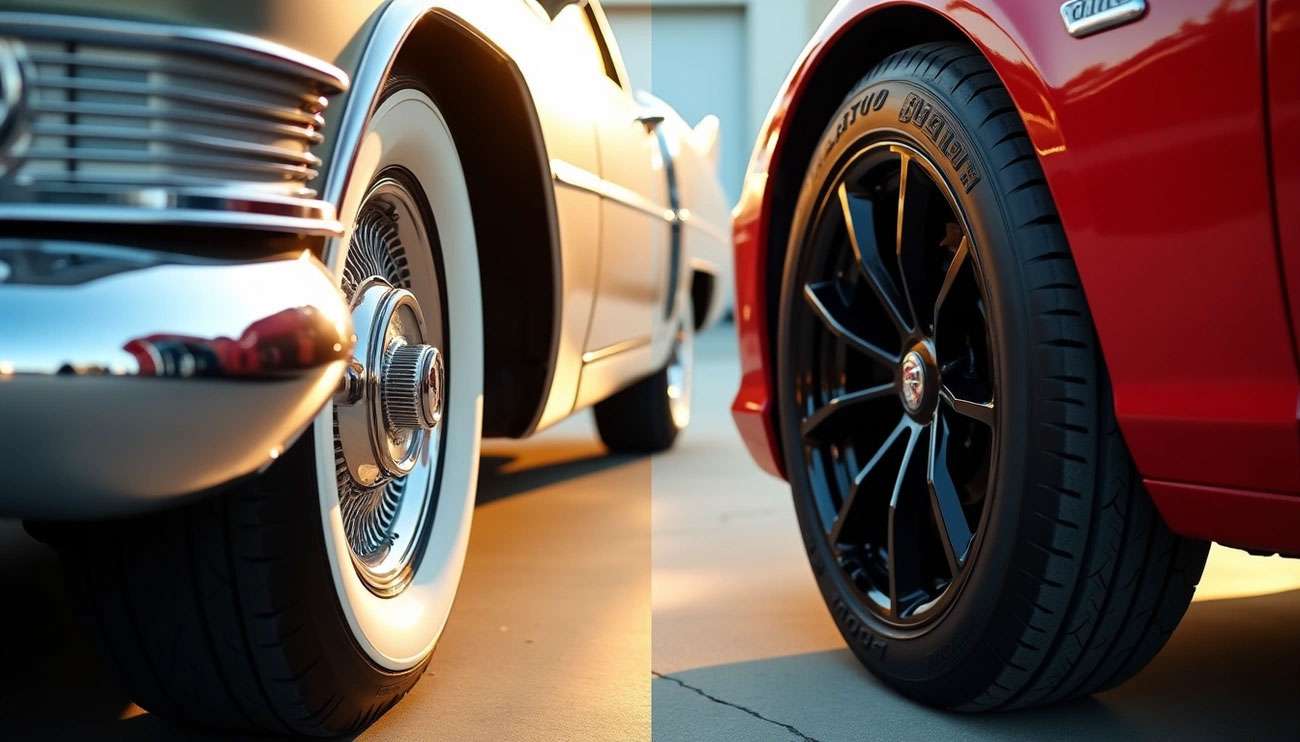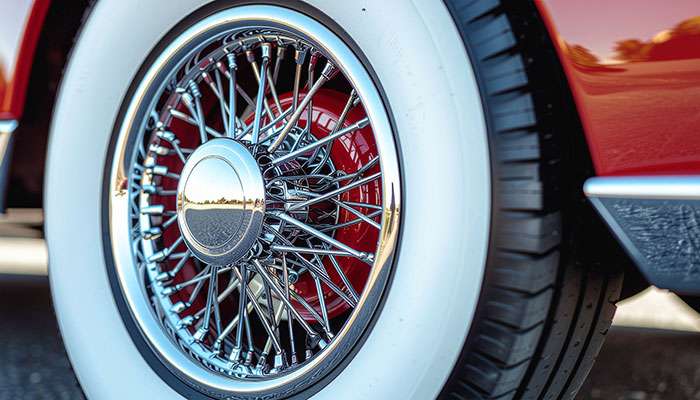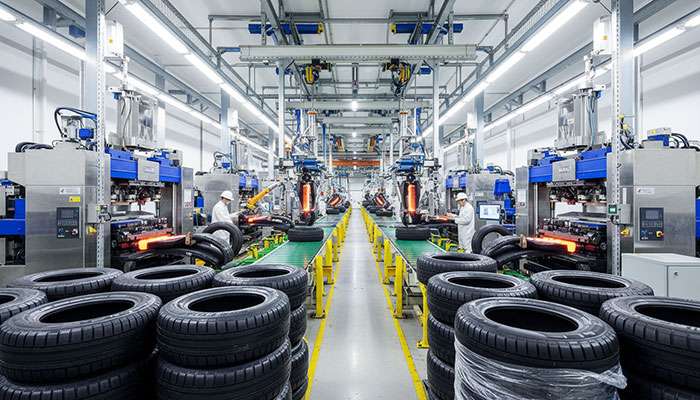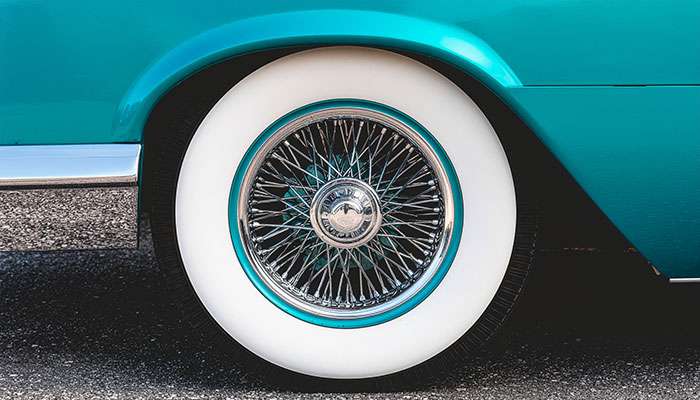
What happened to white wall tires that once defined automotive elegance? These distinctive tires, with their striking white rubber stripes along the sidewall, ruled American roads from the early 1900s straight through the mid-1980s. Ford made history as the first automaker to offer them as a factory option in 1934, setting the price at just $11.25 per set—that's $264 in today's money.
White wall tires dominated nearly every major automobile for decades. The shift started during the 1970s when manufacturers embraced radial tire technology and carbon black compounds, making black wall tires the new standard. Wide whitewalls had already begun their exit by 1962, marking the end of an era.
Today, you'll find these once-common tires only in specialty markets, serving classic car enthusiasts who pay around $150 per tire for authentic period looks. The story behind their disappearance involves more than just changing fashion trends—it's a tale of manufacturing costs, performance limitations, and evolving consumer priorities that ultimately sealed their fate.
Understanding why whitewalls vanished reveals important lessons about how practical considerations shape automotive design. We'll examine the real factors that transformed these luxury symbols into automotive history.

White wall tires feature distinctive white stripes or bands running along the sidewall, creating a bold contrast against black tread areas. These bands varied dramatically throughout automotive history—from narrow pinstripes to impressive three-inch wide bands, depending on the era and manufacturer preferences.
Early automotive tires appeared naturally off-white because that's the color of natural rubber in its unprocessed state. Tire manufacturers discovered that adding zinc oxide to rubber compounds served a dual purpose—it brightened the white appearance while significantly improving tire durability. These all-white tires represented standard manufacturing rather than luxury styling, simply reflecting the available materials and processes of the time. Road conditions created immediate problems, however, as the predominantly dirt roads quickly turned white tires an unappealing beige color.
The whitewall tire emerged from a manufacturing innovation rather than design intent. B.F. Goodrich revolutionized tire construction in 1910 by incorporating carbon black into rubber compounds, dramatically improving strength and durability. This breakthrough proved essential for handling the rough road surfaces common during that era.
Smaller tire manufacturers recognized the benefits of carbon black but faced cost constraints. They applied carbon black only to tread areas where strength mattered most, leaving sidewalls in their natural white state as an economy measure. This cost-cutting approach accidentally created the first whitewall appearance—black treads paired with white sidewalls.
The accidental aesthetic proved surprisingly appealing to consumers and manufacturers alike. Luxury automakers like Duesenberg embraced whitewalls during the 1920s, recognizing their visual impact on high-end vehicles. Conservative manufacturers remained hesitant to offer them as standard equipment until the market demonstrated clear demand.
Ford's decision to offer whitewalls as a premium option established them as luxury items rather than manufacturing accidents. This pricing strategy transformed what began as a cost-saving measure into a clear status symbol.
Whitewall designs evolved significantly over the following decades. Early 1950s models standardized at approximately 3 inches wide. Manufacturers gradually refined the proportions—narrowing to 2½ inches by the mid-1950s, then further reducing to 1 inch by 1962. Premium brands like Cadillac and Lincoln developed distinctive double and triple whitewall patterns to differentiate their top-tier models from standard offerings.

Whitewall tires experienced a remarkable journey through American automotive history. Their evolution tells the story of changing consumer tastes, technological advances, and economic pressures that ultimately reshaped the tire industry.
The decline started around 1962 when wide whitewalls began disappearing from mainstream production. The 1960s brought narrower alternatives—red and white stripe combinations appeared on Thunderbirds, while Cadillacs and Lincolns featured distinctive triple white stripe designs.
Sports cars led the exodus from whitewalls. Chevrolet dropped them from Corvettes after 1974, and Ford's Mustang advertisements abandoned the look by 1983. Luxury manufacturers proved more stubborn—Lincoln continued featuring whitewall tires in their brochures until 2010, marking the end of factory whitewall options.
Wide whitewalls measuring 3-4 inches dominated the luxury car market during their golden era. Premium brands like Packard, Cadillac, and Lincoln made them standard equipment on flagship models. Ford's 1934 decision to offer whitewalls as a factory option democratized the feature, though the $11.25 price tag still marked them as premium upgrades.
World War II created an unexpected boost for whitewalls. Rubber shortages during wartime made them unavailable, which actually increased their desirability once production resumed. The post-war economic boom saw their popularity reach new heights.
Design evolution continued throughout this period. Mid-1950s whitewalls standardized at 2-3 inches wide, then narrowed further to 1-2 inch bands by the late 1950s. These changes reflected manufacturers' attempts to maintain the distinctive look while reducing costs.
Multiple forces converged to end the whitewall era. The oil crisis shifted consumer priorities toward fuel efficiency rather than appearance. Radial tire technology, which offered superior performance and longevity, proved difficult to manufacture with traditional whitewall construction methods.
European imports popularized sleeker, sportier designs that favored black sidewalls. American manufacturers followed suit, gradually phasing out whitewalls from their standard offerings. The transition accelerated as car buyers increasingly valued performance metrics over traditional luxury styling.

Several interconnected factors ended the whitewall tire era. Manufacturing economics, performance limitations, and changing consumer preferences created a perfect storm that made these once-popular tires obsolete for mainstream production.
Whitewall tire production demanded substantially higher costs than standard black tires. The white rubber compound required additional processing steps and specialized materials, while the assembly process needed precise application of white sidewall bands—a labor-intensive procedure that couldn't be easily automated.
Manufacturers faced additional expenses maintaining separate production lines and inventory systems for whitewall variants. The grinding process required to create clean whitewall edges added another cost layer. These factors combined to make whitewalls roughly 20-30% more expensive to produce than comparable blackwall tires.
The specialized equipment required for whitewall production became increasingly difficult to justify as demand declined. Tire manufacturers faced a choice: invest in updating whitewall production capabilities or redirect resources toward emerging tire technologies that promised better returns.
White rubber compounds contained zinc oxide and other lightening agents that compromised tire performance compared to carbon black formulations. The white rubber sections proved less resistant to ozone degradation, weather damage, and general wear than black rubber areas.
Whitewall tires showed visible discoloration faster than blackwalls, developing yellowish or brownish stains from road grime, brake dust, and tire dressing products. This appearance problem required constant maintenance—owners needed to clean whitewalls regularly using specialized products to maintain their distinctive look.
The structural limitations became more apparent as tire technology advanced. Whitewall construction didn't adapt well to radial tire designs, which offered superior handling, longer tread life, and better fuel economy. Modern low-profile tire designs, essential for contemporary vehicle performance, proved incompatible with traditional whitewall aesthetics.
Automotive styling shifted dramatically during the 1970s and 1980s. European sports cars popularized sleeker, more minimalist designs that emphasized performance over luxury ornamentation. Blackwall tires better complemented these modern aesthetics, making whitewalls appear dated and out of touch.
The muscle car era brought performance-oriented buyers who prioritized handling and speed over traditional luxury styling. These enthusiasts gravitated toward blackwall tires, particularly those with raised white letters that conveyed sportiness rather than formal elegance.
Practical considerations influenced consumer choices as well. Busy car owners appreciated low-maintenance blackwall tires that didn't require regular cleaning to look acceptable. The time and effort needed to keep whitewalls clean became a dealbreaker for many buyers, especially as two-income households became more common.
The transition from bias-ply to radial tire construction fundamentally altered tire manufacturing. Radial tires offered measurable improvements in fuel efficiency, tread life, and handling characteristics. These benefits proved compelling enough to drive complete market transformation within a single decade.
Radial tire manufacturing processes didn't accommodate traditional whitewall construction methods efficiently. The industry made a collective decision to standardize on blackwall production, which simplified manufacturing, reduced costs, and aligned with emerging performance standards.
Safety regulations and performance requirements increasingly influenced tire design. Modern vehicles demanded tires that could handle higher speeds, heavier loads, and more sophisticated suspension systems. These requirements pushed tire development toward uniformly black constructions that maximized structural integrity.

White wall tires haven't disappeared entirely—they've simply moved into specialized markets where classic car enthusiasts and custom builders keep the tradition alive. These specialty tires serve a dedicated customer base that values authenticity over mainstream appeal.
Whitewall tires remain completely legal worldwide. The Lincoln Town Car held the distinction as America's last factory whitewall option until production ended in 2010. The UK saw its final factory whitewalls on the Kia Pride. Their rarity stems from manufacturing economics, not regulatory restrictions.
Modern cars can absolutely run whitewall tires. Today's whitewalls use radial construction to meet current safety and performance standards, replacing the original bias-ply designs. Contemporary versions typically feature narrower white bands than their vintage counterparts, but they deliver the classic appearance enthusiasts seek.
Several specialty manufacturers maintain whitewall production. Vogue Tire leads with over 111 years of experience, offering distinctive white/gold and white/red sidewall combinations. Check out Performance Plus Tire for a comprehensive selection of quality whitewall options. Other established manufacturers include Coker Tire, Diamond Back Classic, and Calli Whitewall Tires (founded 2010).
Expect to pay around $150 per tire, though prices range from $60 to $435 depending on size and specific design requirements. This premium pricing reflects their specialized manufacturing process and limited production volumes.
Raised White Letter (RWL) tires offer a popular alternative that emerged from racing applications during the muscle car era. Performance vehicles like Camaros and Corvettes began featuring them as factory options around 1969. For budget-conscious enthusiasts, companies like TredWear produce raised white letter inserts that adhere to existing tires, providing the classic look without complete tire replacement.
We carry an extensive selection of specialty tires for classic car applications. Our expert team can help you find the perfect whitewalls to match your vehicle's original specifications and ensure proper fitment for both authenticity and performance.
White wall tires vanished from mainstream production when practical realities overtook style preferences. Manufacturing costs proved too high, white rubber couldn't match black rubber's durability, and the 1970s radial tire revolution made blackwalls the clear performance choice.
These factors created a perfect storm that ended the whitewall era. Modern automotive design demanded low-profile tires for better handling, something traditional whitewall construction simply couldn't deliver. When consumers started prioritizing performance and convenience over appearance, the high-maintenance whitewalls lost their appeal.
The story of whitewalls shows how automotive trends evolve—from accidental discovery to luxury symbol to specialty product. What started as a manufacturing cost-saving measure became the ultimate status symbol before practical considerations made them obsolete for everyday use.
Classic car enthusiasts keep this tradition alive today. Specialty manufacturers continue producing quality whitewalls for restoration projects and custom builds. At Performance Plus Tire, we carry a comprehensive selection of whitewall tires designed to meet the authentic needs of vintage vehicle owners. Our selection includes various sizes and styles to match nearly any classic application.
White wall tires represent more than just a styling choice—they capture an entire era of American automotive culture. When you see those distinctive white stripes, you're looking at a time when cars served as rolling statements of prosperity and style. That legacy continues today through dedicated enthusiasts who understand the importance of authentic details in preserving automotive history.
White wall tires disappeared from mainstream automotive production due to a perfect storm of practical and economic factors that made them obsolete by the 1980s.
• Manufacturing costs killed profitability: White wall production required expensive labor-intensive processes, special compounds, and custom grinding that couldn't be automated effectively.
• Performance limitations sealed their fate: White rubber was less durable than black, discolored easily, and couldn't accommodate modern radial tire technology or low-profile designs.
• Consumer priorities shifted dramatically: Car buyers moved from valuing esthetic appeal to prioritizing performance, safety, and low-maintenance convenience over high-maintenance styling features.
• Technology made them obsolete: The 1970s introduction of superior radial tire technology favored black wall construction for better handling, safety, and fuel efficiency.
• Niche market survives today: Specialty manufacturers like Coker Tire and Vogue still produce whitewalls at premium prices ($150+ average) exclusively for classic car enthusiasts and custom builds.
While white wall tires represented automotive luxury for over 50 years, their decline illustrates how practical considerations ultimately triumph over pure esthetics in automotive design evolution.
Whitewall tires declined due to several factors, including higher manufacturing costs, performance limitations compared to black tires, changing consumer preferences, and the automotive industry's shift towards low-profile tires that were incompatible with whitewall designs.
Yes, whitewall tires are still available, but primarily as specialty items for classic car enthusiasts and custom builds. Companies like Vogue Tire, Coker Tire, and Diamond Back Classic continue to manufacture them, typically priced around $150 per tire.
The popularity of whitewall tires began to wane in the 1960s. Wide whitewalls generally disappeared by 1962, with narrower versions persisting through the early 1970s. Most mainstream manufacturers had phased them out by the 1980s.
Originally, whitewall tires were a symbol of luxury and style. They added a distinctive esthetic to vehicles, particularly in the 1930s to 1960s. However, they didn't offer significant performance advantages over black tires and eventually became less practical.
While it's possible to fit whitewall tires on some modern cars, it's not common or practical for most vehicles. Modern whitewall tires are typically radial construction to meet current safety and performance standards, but they may not be compatible with many contemporary vehicle designs that favor low-profile tires.